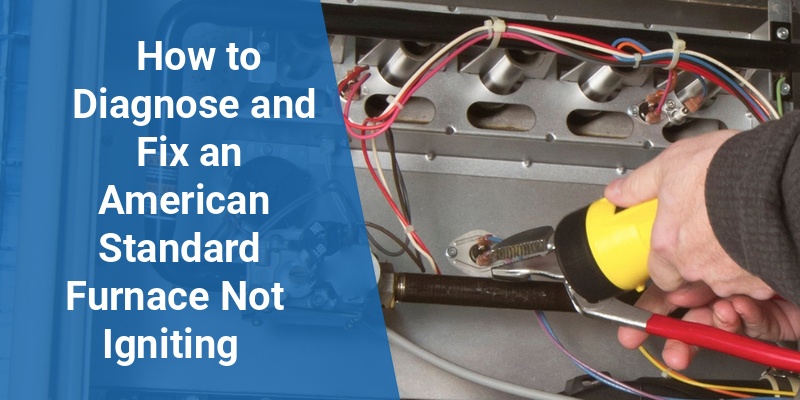When an American Standard furnace fails to ignite, it can lead to discomfort and concern, especially during cold weather. Understanding why your furnace is not starting and knowing the appropriate troubleshooting steps can save time, money, and hassle. This article outlines common causes, diagnostic tips, and effective fixes specifically for American Standard furnaces, helping homeowners quickly restore reliable heating.
| Common Causes | Symptoms | Potential Solutions |
|---|---|---|
| Dirty or Faulty Igniter | Clicking sound but no flame | Clean or replace igniter |
| Thermostat Issues | Furnace not responding to settings | Check and recalibrate or replace thermostat |
| Gas Supply Problems | No gas smell, furnace won’t light | Check gas valve and supply, call propane/gas company if needed |
| Flame Sensor Malfunction | Furnace starts but shuts off quickly | Clean or replace flame sensor |
| Clogged Air Filter | Overheating and safety shutdown | Replace air filters regularly |
Common Reasons an American Standard Furnace Won’t Ignite
American Standard furnaces rely on precise ignition and safety components to start and maintain a flame. When your furnace refuses to ignite, it typically relates to one or more common problems. Igniter failure is a frequent culprit, often caused by dirt, wear, or electrical faults. Other significant causes include thermostat malfunctions, interruptions in the gas supply, or issues with the flame sensor, which detects the presence of a flame and automatically shuts down the furnace if flame is not detected.
Another frequent problem is a dirty or clogged air filter, which restricts airflow and can cause the furnace to overheat and shut down before ignition. Additionally, safety switches, for example, the limit or rollout switches, can prevent ignition if they detect unsafe conditions.
Diagnosing the Ignition Failure in Your Furnace
To pinpoint why your American Standard furnace is not igniting, begin with a systematic diagnosis of each possible issue. First, verify that your thermostat is set correctly and that it calls for heat. Sometimes, thermostat batteries need replacement or calibration is off, causing the furnace not to receive a proper signal.
Next, listen for the distinct clicking sound associated with the igniter attempting to start the furnace. If you hear clicking but no flame appears, the igniter may be faulty. If there’s no sound, inspect electrical connections and the control board.
Confirm that the gas supply is uninterrupted. Any interruption, a closed valve, or pilot light issues lead to ignition failure. Smelling gas or fire safety concerns warrant immediate professional attention.
Another diagnostic step is to check the flame sensor. A dirty flame sensor may cause the flame to ignite momentarily then shut off, creating a recycling ignition sequence. Cleaning the sensor with fine steel wool often resolves this.
Call 888-906-9139 for Free Local HVAC Quotes – No Obligation, Just Savings!
How to Reset and Relight an American Standard Furnace
Many American Standard furnaces allow a manual reset or relight after ignition failure. Locate the reset button on the furnace control board, then press and hold it according to the manufacturer’s instructions (typically 3-5 seconds). This process can clear system faults and allow another ignition attempt.
Before resetting, ensure the furnace power switch, usually near the unit, is on, and confirm the thermostat is set to “heat” and the temperature setting is above room temperature. If your furnace uses a pilot light, you may need to manually relight it per the user manual.
Replacing the Igniter or Flame Sensor in an American Standard Furnace
If diagnostics point to a faulty igniter or flame sensor, professional replacement is recommended, but informed homeowners can perform this with basic tools and precautions. Cooling the furnace first and disconnecting power ensures safety.
The igniter is typically a small ceramic or metal rod located near the burner assembly. Remove screws securing it, disconnect electrical connectors, and install the new part carefully to avoid damage.
The flame sensor is a thin metal rod mounted in front of the burners. Remove it, clean it with fine sandpaper or steel wool, or replace it if cleaning does not restore proper function.
Maintaining Your American Standard Furnace to Prevent Ignition Problems
Routine maintenance dramatically reduces furnace ignition issues. Replace air filters every 1 to 3 months depending on usage and environmental conditions to ensure proper airflow. Inspect the igniter and flame sensor annually and clean or replace as needed.
Have a licensed HVAC technician perform a thorough inspection before the heating season begins. This includes checking gas pressures, safety switches, electrical controls, and heat exchangers to maintain safe and efficient operation.
Call 888-906-9139 for Free Local HVAC Quotes – No Obligation, Just Savings!
When to Call a Professional HVAC Technician
Certain issues with American Standard furnaces require professional expertise, especially anything involving gas valves, burners, or internal components. If troubleshooting steps do not resolve ignition problems or if you detect a gas smell, do not attempt further repairs yourself.
Qualified technicians have specialized tools to diagnose control board failures, deep electrical issues, or complex safety switch malfunctions. Professional service ensures longevity, safety, and optimal furnace performance.
Tips to Avoid Future Furnace Ignition Failures
- Keep the furnace area clean and free of dust and debris that can impair ignition components.
- Replace filters regularly to maintain airflow and prevent overheating.
- Schedule annual professional tune-ups to catch and address wear before it causes failures.
- Upgrade old thermostats to programmable or smart models for improved control and reduced cycling.
- Ensure proper ventilation around the furnace to maintain optimal combustion air supply.
